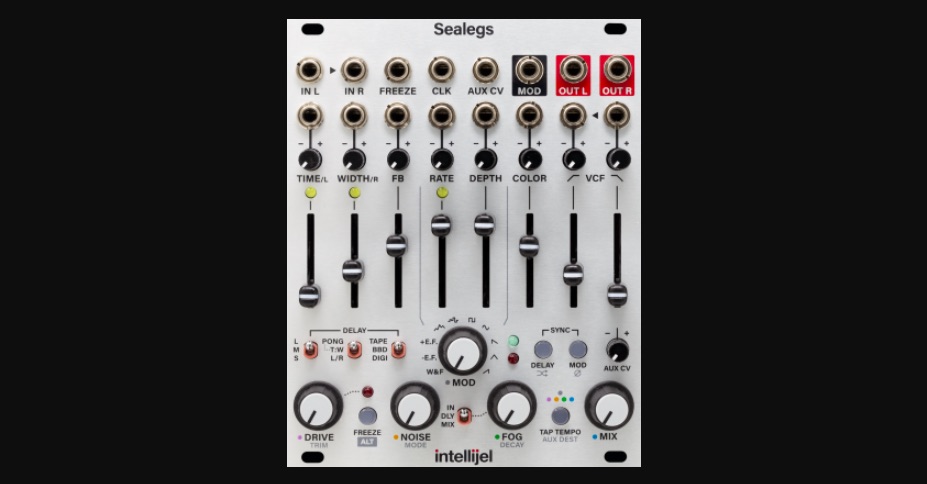Versatile delay with an emphasis on hands-on control as well as CV modulation. Greg Scarth takes a deep dive into Intellijel’s latest offering.

Anyone with an interest in modular synths is almost certainly familiar with Intellijel. The Canadian brand has been around since before the Eurorack scene went stratospheric, serving up consistently good modules across the board. We’ve previously raved about the excellent Metropolix sequencer and semi-modular Cascadia synth among others, but frankly there isn’t a dud offering in the company’s entire catalogue, from simple utility modules through to more exotic options such as the Plonk percussion synth and Shapeshifter wavetable VCO. The new Intellijel Sealegs module is the brand’s latest offering, and it’s a relatively straightforward proposition, a multi-mode stereo digital delay. At least, so it seems until you dig deeper and realise just how much more the Sealegs can do.
Take a closer look at the front panel and what you soon realise is that Intellijel might be underselling the Sealegs, in more ways than one. Firstly, this isn’t by any means JUST a delay effect. The delay section itself is the multi-mode digital heart of the module, offering Tape, Bucket Brigade, and Crossfading Digital modes, but it’s surrounded by additional circuits which add up to a sort of delay-based multi-effects setup. On the input, you’ve got the option to drive the signal and add saturation. Pre- or post-delay reverb is complemented by pre- or post-delay his and crackle effects, while dual low-pass and high-pass filters allow you to dial in the tone of your repeats.
Aside from the main functionality, a lot of work has clearly gone into the interface and hands-on feel of the Sealegs. There are no presets and there isn’t even a screen to look up parameters, let alone any form of menu diving. Instead, almost every parameter has its own dedicated control, with just a few alt functions for less frequently used settings. Just as importantly, all eight of the main parameters (time, width, feedback, modulation rate and depth, colour and two filters) have their own attenuverted modulation inputs above their slider, giving you manual and/or CV control of almost everything.
The three modes complement each other very nicely, offering distinct flavours of echo which lend themselves nicely to a range of different sounds: Tape mode for twangy echoes with dropouts, BBD for that distinctive analogue lo-fi character and Digi for vintage granular delay with 70s/80s aliasing effects (by no means a pristine, characterless digital sound). What’s particularly pleasing is the way that each model behaves slightly differently in terms of control and character. In particular, the dedicated Color control introduces ‘tape-related degradations’, ‘BBD-related sonic anomalies’ or ‘digital-centric irregularities’ depending on the mode, accentuating and amplifying the character of each algorithm.
Above all, what feels particularly clever about the Sealegs is how it marries the two approaches of direct, real-time, hands-on tweaking and CV modulation. The extensive dedicated controls mean that you can ‘play’ the module with a sequence running through it, performing dub-style mixing effects in Tape mode, or creating interesting tempo-synced effects in Digi mode. But this goes hand in hand with all those dedicated attenuverter CV inputs (plus an assignable aux input), which allow you to set up extremely complex modulated delays. Sync the master tempo using a clock signal, then patch in LFOs, envelopes, sequencers, joysticks and the like to create something which walks the tightrope of real-time control and organised modulation chais.
All of which adds up to something uniquely engaging and playful as part of a bigger patch. While the Sealegs doesn’t impose its own character on a signal in the way some effects might, it offers you the option of pushing it in countless different directions depending on what sound you’re feeding into it. Throw in some techno snares and you can get gritty and intense. Aim for dub territory and it’ll get loose and smoky. Run an acid bassline and it’ll get pleasingly psychedelic. It’s a genre-agnostic module which responds to your inputs rather then leading you down a single path.

Don’t underestimate the internal modulation generator, either. While you can go crazy with the external modulation signals and create woozy, shifting patches which sync and unsync over time, the on-board mod functions are more powerful than you might expect. A choice of ten settings includes basic LFO effects as well as two complex, randomised options in the form of a Low Frequency Vacillator and Sample & Hold, while the W&F setting (wow and flutter) is ideal for adding a bit of old-school imprecision to tape echo effects. Dial positions in between settings allow you to choose crossfaded combinations of two shapes.
When it comes to Eurorack delay modules, there are plenty of options to choose from. So where does the Sealegs fit in? At just under £400, it’s positioned around the same kind of price range as the more experimental Make Noise Mimeophon and the more loop-focussed 4ms Dual Looping Delay. A slightly more affordable option is the Timiszoara 1970 multi-effect module from Xaoc Devices, which offers broadly similar stereo effects including plenty of delay and reverb programs, but it highlights the main strength of the Sealegs in its single-function controls and extensive CV inputs; the Timiszoara offers just four real-time sliders and corresponding CV inputs.
The Sealegs is arguably less distinctive than something like the Mimeophon, for instance, but its versatility matches perfectly with its depth, offering something which can be pleasingly simple or wildly complex depending on what you’re looking to achieve. A much deeper module than its description might suggest, the Sealegs is a fantastic option.
Greg Scarth
More info/buy